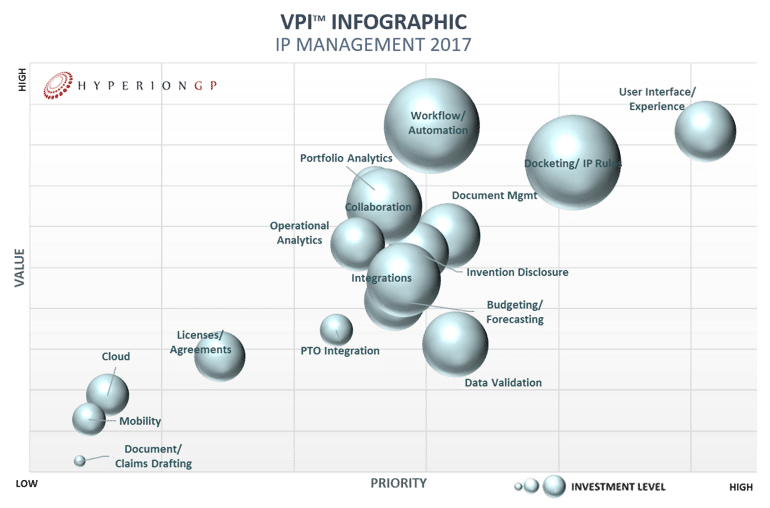
Demonstrating ROI in IPM
Hyperion Research’s proprietary VPI InfographicTM plots current market sentiments regarding trending IPM disciplines and competencies for relative Value, Priority, and Investment to organizations. The VPI Infographic’s competency matrix demonstrates the comparative value and priority ascribed to the core IPM capabilities; each capability is plotted on value and priority axes, while the size of each bubble represents relative levels of investment for each.
For 2017, the IPM VPI InfographicTM illustrates a desire for interconnectedness among the available tools and functions – nee operational contexts – that increase business visibility and engage the user.

Engaging the User and Demanding a Better Experience
User experience was a standout performer in this year’s benchmarking. Though many other tech competencies saw higher investment, none resonated with the market more than the pursuit of more intuitive user interfaces that help to streamline data entry, access and management. A meaningful visual experience is key to the IPBM paradigm, including integrated dashboards, dynamic and contextual matter views, engaging reporting and the expansion of automation capabilities. We’ve observed solution priorities that focus on driving “click counts” way down, and “sexiness” way up. The growing presence and importance of mobility in legal also drives the appetite for an experience that can translate uniformly across all platforms. As the speed of business increases, so does the need to keep pace and to access just-in-time data to support decision-making.
Vendors are actively heeding this demand. Certainly, with the advent and ensuing widespread adoption of HTML5 and its broad capability toolkit, nearly all solution providers have incorporated “HTML5 interface refreshes” into their roadmaps. Several of our Advanced Solution Providers have recently introduced—or plan to introduce—new UIs that emphasize the rich HTML5 elements that make their pages more appealing to the eye and more intuitive to the user, both embedding business intelligence and analytics in an attractive and useful manner.
Always Central to IPM, Docketing Evolves
Data entry – and the data entry user – are no longer the primary focal point of IPM. That does not mean, however, that docketing and the related processes are in any way less significant. The objectives of IP Management are broad and diverse, but the ardent requirement for risk management is and always will remain a core tenet. Our VPI chart demonstrates, as it does every year, the continued vigilance of IP docketing sophistication and the importance of IP rules and rules support. Leading solution providers have understood this, increasing investments in rules engines and annuity management capabilities even as they expand the reach of their systems into broad IPBM disciplines. But the need for docketing sophistication and automation has also seen the introduction of advancements for improved engines for country law maintenance, docket workflow management, integrated reporting and notification tools, and perhaps most notably, the increasing use of PTO and private PAIR integrations that automatically download application dockets and file-wrapper data directly into the IP systems. These novel approaches to integrating “big data” with process automation, we believe, will serve to radically transform the deeply embedded manually driven process of IP prosecution. We also expect this dynamic to drive fundamental shifts in the employ of human resources for IP Management; not to reduce headcount, but to leverage existing resources for higher value work while automating more menial, routine tasks.
Other VPI Observations
- This year’s chart paints a picture that assuredly support the core tenets of IPBM, particularly in the orientation of the Operational and Performance Analytics, Integrations, Document Management, Invention Disclosure and Budgeting/Forecasting categories in the Value/Priority matrix. The gravitation of these disciplines together demonstrates – and amplifies – the broad and holistic approach to IP asset management that defines and drives the IPBM model.
- Though Document and Claims Drafting emerges on this year’s matrix – consistent with our market observations – we are surprised by the leaden sentiments ascribed to the one category specific to tools focused on actual work product creation. We suspect that the historical scarcity of such tools in the market, those specifically focused on helping attorneys do their original work, presents a dynamic of both enthusiasm for their emerging availability, but also general market unfamiliarity with their existence.
- Conventional wisdom dictates that mobility and the Cloud are an inevitable part of the infrastructure outlook moving forward. Yet our matrix also signals a sharp contrast among legal operations managers, administrators and practitioners between practice management concerns and infrastructure. It’s a notable dissonance, as both capabilities feature prominently in the solution roadmaps presented later in this report.
- Data Validation features prominently as a growing and assured priority. IP data is complex, often convoluted and, with a daunting inherent risk profile, a consistent source of anxiety for management. The demand for tools that help organizations manage, clean, monitor and normalize their data is growing as automation, sophistication and innovation begin to emerge to reinvent this once tedious and onerous discipline.


